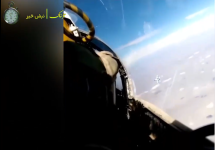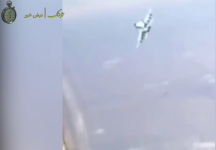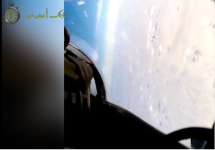Then prove us that the Brazilian and European systems specifications are also correct from the paperCome on ... Does anyone really believe the specifications of Russian systems?? They are not worth the paper they are written on - you only have look at the poor performance of Russian systems to know their paper specs are just that, paper specs ..
Navigation
Install the app
How to install the app on iOS
Follow along with the video below to see how to install our site as a web app on your home screen.
Note: This feature may not be available in some browsers.
More options
Style variation
You are using an out of date browser. It may not display this or other websites correctly.
You should upgrade or use an alternative browser.
You should upgrade or use an alternative browser.
Iranian Air Force (IRIAF/IRGC-ASF) | News and Discussions
- Thread starter Persian Gulf
- Start date
AmirIGM
Senior Member
- Dec 13, 2015
- 4,224
- 8,752
- Country of Origin

- Country of Residence

I think you've misunderstood. A pilot/RIO/WSO has no control over the responses his own IFF transponder sends other than perhaps turning it on or off. I meant the aircraft sending out the IFF query. It sends out a query, that is then interpreted by the receiving aircraft's IFF transponder and if it can decode the encryption it will send a response. That is received by the querying aircraft and it shows up on the display (example below from the F-14). However if the receiving aircraft cannot decode the query then it will not send a response. This is why I say unknown - there is simply no response, so it may not necessarily be a hostile aircraft. It could be a fighter plane from a different but friendly country, it could be a civilian airliner, it could even be a friendly military aircraft with no IFF system (think N Korea with its An-2s lol).Only if he has the IQ of a cucumber.
Not sure if anyone in their right mind would ever want to tell his enemy that yes, I am your foe so go ahead and shoot me!
Now the querying aircraft's pilot (or in the F-14's case, RIO) could manually select that target on his display and designate it as hostile, but he'd need to be really really sure. Usually by AWACS or ground control confirmation, or by visual/long range camera confirmation. Or by an educated guess (usually not allowed).
The rest of your post on IFF is mostly accurate.
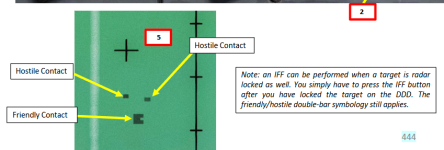

^ That's the Computer Address panel in the F-14 RIO's seat. Among other things, it's used to designate the status of targets in the AWG-9 WCS and displays. The RIO would highlight ("hook") a target then press those buttons next to the words to designate its status as per below.
FRIEND - FRIENDLY
UNK - UNKNOWN
HOST - HOSTILE
This whole convo reminded me of a pretty funny but helpful short (59s) video explaining IFF, so feckless new DCS players don't join a new server and immediately start shooting down friendlies (*cough* hornet noobs *cough*)
Yes... though that's an SR-71B trainer. The SR-71A looked like thisHe also was in a completely separated cockpit.

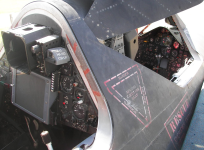
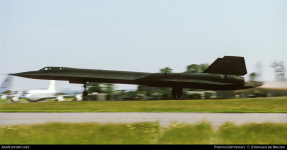
With the Su-35 and Irbis it's just saying Phased array. The Irbis is a phased array - all PESAs are. I believe that's what it's talking about regarding the 170 units on Su-35s - the Irbis radars which they're all fitted with.According to Tikhomirov NIIP Research Institute which runs the Almaz-Antey Air and Space Defense Corporation which developed these onboard phased array radars, the AESA wing arrays are AESA radars and were tested on both, the Su-35S and Su-57.
According to Yuri Bely, in 2016 an unprecedented volume of test flights was carried out to test the latest Tikhomirov radars - a total of more than 370 flights, including more than a hundred on fifth-generation T-50 aircraft with a multifunctional electronic system based on AESA and more than 170 on Su-35S fighters with Irbis radar with phased array.
This part suggests that the three elements we thought are part of the arrays (radar, ECM & IFF) are actually separate, and that the arrays function strictly as AESA radars.
Funny you should mention that because I searched type 4283 IFF and got this image, which seems to suggest the wing leading edge array is part of the 4283 IFF system.The first section above mentions how they're separate components and we can see here that the IFF unit (item 4283) is separate from the arrays and is either the processing unit or possibly the receiver/transponder.

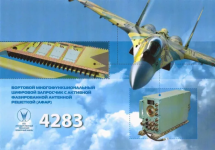
This is incorrect. PESA is Passive Electronically Scanned Array. They can scan electronically which is one of the main benefits of all ESAs over MSAs. The only reason the Irbis is ALSO mechanically scanned (which I explained in my blog post) is that electronic scanning in both PESAs and AESAs is limited to +/-60 degrees. So the Irbis array can be steered an additional +/- 60 degrees mechanically, meaning a maximum of 120 degrees so the Su-35 can technically hold a lock and guide a missile to a target while flying perpendicular to or even slightly away from it (not advisable - track quality degrades at the edge of the radar beam). Most PESAs and AESAs are fixed and can't do that but there are even some AESAs that can be mechanically steered, a prominent example being the EF Typhoon's Captor-E (to say nothing of some ground based radars which can rotate for 360 degree coverage). That's why I said PESAs and AESAs share many of their benefits over MSAs, the main one being that they are FAST FAST FAST. MSAs can't do ANY electronic scanning, only mechanical steering of the radar antenna.But if you have a PESA (hybrid) radar which has to mechanically steering but with great output power and at great distances and also scan electronically with the addition of AESA arrays, you're almost at AESA capability.
AESAs have access to some more complex scan properties like different frequencies. Even within X-band which is between 8-12 GHZ, if a radar operates in the 10 GHZ range it can change/hope between frequencies to fool RWR/ECMs and the like (think like frequencies at 10.01 GHZ, 10.02, 10.04, 10.043, 10.049 etc...). And multiple beams and such. But this is a different and complex topic and I'm told PESAs can do some of the beamforming elements just to a lower/different extent.
Best way to understand this is look at how the radars physically work
How does a PESA radar work?
I have been trying to understand how a PESA radar works. Essentially, it uses one signal that is electronically delayed. How is the reception coordinated and known by the receiver? I am interested...
Last edited:
GoMig-21
Elite Member
- Oct 16, 2016
- 9,269
- 14,353
- Country of Origin

- Country of Residence

I think you've misunderstood. A pilot/RIO/WSO has no control over the responses his own IFF transponder sends other than perhaps turning it on or off. I meant the aircraft sending out the IFF query. It sends out a query, that is then interpreted by the receiving aircraft's IFF transponder and if it can decode the encryption it will send a response. That is received by the querying aircraft and it shows up on the display (example below from the F-14). However if the receiving aircraft cannot decode the query then it will not send a response. This is why I say unknown - there is simply no response, so it may not necessarily be a hostile aircraft. It could be a fighter plane from a different but friendly country, it could be a civilian airliner, it could even be a friendly military aircraft with no IFF system (think N Korea with its An-2s lol).
Ah, yes, got it, I did misunderstand. You were referring to the "querying" pilot and not the "unknown" aircraft's pilot. You're right because it is automated and if the pilot of the unidentified aircraft is a hostile or enemy, will not respond anyway, hence the unknown signal and querying pilot having the discretion to designate it hostile for his own reasons.
The cucumber level IQ was under the assumption that you were referring to the pilot in the unknown aircraft and if somehow he decides "at his own discretion" to signal the querying pilot that he is the enemy lol. Obviously that would be about as dumb as it would get lol. Even if it's possible in the first place which I'm guessing it's not. Sorry that I even thought that you would even suggest such a thing! My bad lol.
Yes... though that's an SR-71B trainer.
Yep, supposedly, anyway. And it makes sense to have that config as a trainer. It's the same thing the Russian even did with the MiG-25 UP and the R was a single seater. The UP trainer, unlike the Sr-71 trainer we could see did not have the camera equipment. But from my understanding is that was a way to save money. Same thing with the early MiG-29UM for trainers, those wouldn't have radars for example to save manufacturing costs. That aspect of training can be done later in a single seat.
But it actually makes more sense to fly actual missions in that separated configuration. Why separate a trainee? A combined cockpit would actually be the better option for a trainee, in case the instructor needs to have some clear & immediate visual indication that the trainee is struggling with anything, especially physically. I believe that when they built trainer models with these separated cockpits, they intended to have the instructor in the rear cabin so that his overall visual orientation is always forward and can quickly take over flight control in an emergency situation. On the other hand, a separated cockpit seems much more ideal (and BTW, this is a very legitimate reason even as funny as it may sound) during super long-distanced missions and the brutally long time the pilots are subjected to and had to endure sitting inside those cockpits, and what was their means of relieving themselves, especially #2? lol. It's a big concern & problem where they had piddle bags to use for #1, but not #2 lol. And believe it or not (this is a reality) they had no choice but to go. Let it out, bro. And the stank it would create for another what, 11 hours or whatever? Wouldn't it be much better contained in a separate cabin? lol Imagine what the poor pilot flying the plane would have to put up with smelling that stankass sewage in a tight cockpit. This might seem trivial and silly but you would think they had to have considered all these things. @FuturePAF posted a great video about how the USAF has come up with a new "piddle bag" system that at least makes it much easier than the original one, and for both, male & female to relieve themselves, but it still doesn't address #2 lool.
Anyway lol, sorry to go off on an off-topic tangent. My original point was just that there was a 3rd designation to RIO & WSO in the RSO, which apparently was for this specific surveillance & reconnaissance & spying aircraft.
Now the querying aircraft's pilot (or in the F-14's case, RIO) could manually select that target on his display and designate it as hostile, but he'd need to be really really sure. Usually by AWACS or ground control confirmation, or by visual/long range camera confirmation. Or by an educated guess (usually not allowed).
Hence where the ROEs come in. And they are very strict about this kinda thing since they don't want any unintended shoot-downs of course, especially with cargo or civilian aircraft that might not have their IFF responding for whatever reason. They have several checklist points to go through before giving that pilot permission to fire. You are correct, sir.
With the Su-35 and Irbis it's just saying Phased array. The Irbis is a phased array - all PESAs are. I believe that's what it's talking about regarding the 170 units on Su-35s - the Irbis radars which they're all fitted with.
And that's a fair point except as you most likely know very well, some things get lost in translation, literally, from one language to the other and that's automatically translated through PDF by yours truly. So the literature was originally written in Russian and the way sentences are structured in Russian are different than the way they are in English in many instances and the translation algorithm doesn't necessarily pic that up. When he says:
with a multifunctional electronic system based on AESA and more than 170 on Su-35S fighters with Irbis radar with phased array.
That could easily be meant that the IRBIS-E is a multifunctional X band multi-role radar with a passive phased antenna array which it is. And besides, the only reason to test them both on the Su-35S and the Su-57 is because they're both the same AESA arrays but applied to two different main radars.
Funny you should mention that because I searched type 4283 IFF and got this image, which seems to suggest the wing leading edge array is part of the 4283 IFF system.
I think that's what I was trying to say lol. It's part of the entire system as the arrays but is a separate component. It's quite possible it takes inquiring IFF signals from the arrays and then processes them to the IRBIS-E & pilot. In fact, it's more than likely that is its function.
My initial point was to make the distinction that the arrays main function is radar detection and EW and that component being separate is the main IFF processing unit which only takes signals only from the arrays.
This is incorrect.
I think you either misunderstood what I was saying, or I botched it and made grammatical errors or something which I did when I said "steering" instead of "steer" which would've been more appropriate in the context of the sentence. But the rest of your post was pretty much the same thing I was saying.
The IRBIS-E (and I said "hybrid" only because it scans in both manners (PESA & AESA) where the former is mechanically scans and AESA electronically scans. It's simplified because there really is no need to complicate it. That was to make the point that combined with the AESA arrays, it's halfway there to having an AESA radar which is a great benefit to the Su-35S.
AESAs have access to some more complex scan properties like different frequencies.
I mentioned that when I was describing the benefits of AESA operating in several frequencies. You have to take the entire context of what I wrote, it might be more agreeable since it seems to be the same thing you're saying.
Cancerous Tumor
Full Member
- Dec 22, 2023
- 126
- 67
تصاویری منتشر شده که ظاهراً جنگنده F-4 ایرانی خود را پشت F-18 امریکایی قرار میدهد و لحظاتی بر روی آن Lock یا به قولی قفل کرده بود. جنگنده امریکایی برای خروج از این وضعیت، مانوری میدهد تا از قفل کردن فانتوم خلاص شود اما فانتوم نیز با مانور متقابل باز هم پشت آن قرار گرفته و بر روی آن دوباره لاک میکند و در ساعت 12 فانتوم قرار میگیرد. ادعا شده این ویدیو به دلایل امنیتی و اینکه ارتش باید مخفیانه عملیات خود را در سوریه و عراق انجام میداده به تازگی منتشر شده است. این لحظات را میبینیذد.
Google Translate :
Images have been published showing that the Iranian F-4 fighter is placing itself behind the American F-18 and locked on it for a few moments. In order to get out of this situation, the American fighter maneuvers to get rid of the Phantom's locking, but the Phantom is placed behind it with a counter maneuver and locks on it again, and is placed at the 12 o'clock position of the Phantom. It is claimed that this video has been released recently due to security reasons and that the army had to secretly carry out its operations in Syria and Iraq. He sees these moments.

 www.tabnak.ir
www.tabnak.ir
Google Translate :
Images have been published showing that the Iranian F-4 fighter is placing itself behind the American F-18 and locked on it for a few moments. In order to get out of this situation, the American fighter maneuvers to get rid of the Phantom's locking, but the Phantom is placed behind it with a counter maneuver and locks on it again, and is placed at the 12 o'clock position of the Phantom. It is claimed that this video has been released recently due to security reasons and that the army had to secretly carry out its operations in Syria and Iraq. He sees these moments.

تصاویر لحظه قفل کردن جنگنده ایرانی روی F18
تصاویری منتشر شده که ظاهراً جنگنده F-4 ایرانی خود را پشت F-18 امریکایی قرار میدهد و لحظاتی بر روی آن Lock یا به قولی قفل کرده بود. جنگنده امریکایی برای خروج از این وضعیت، مانوری میدهد تا از قفل کردن فانتوم خلاص شود اما فانتوم نیز با مانور متقابل باز هم پشت آن قرار گرفته و بر روی آن دوباره لاک...
No date? I'm sure this is from 2014 where IRIAF was on a bombing campaign with F-4 on ISIS positionsتصاویری منتشر شده که ظاهراً جنگنده F-4 ایرانی خود را پشت F-18 امریکایی قرار میدهد و لحظاتی بر روی آن Lock یا به قولی قفل کرده بود. جنگنده امریکایی برای خروج از این وضعیت، مانوری میدهد تا از قفل کردن فانتوم خلاص شود اما فانتوم نیز با مانور متقابل باز هم پشت آن قرار گرفته و بر روی آن دوباره لاک میکند و در ساعت 12 فانتوم قرار میگیرد. ادعا شده این ویدیو به دلایل امنیتی و اینکه ارتش باید مخفیانه عملیات خود را در سوریه و عراق انجام میداده به تازگی منتشر شده است. این لحظات را میبینیذد.
Google Translate :
Images have been published showing that the Iranian F-4 fighter is placing itself behind the American F-18 and locked on it for a few moments. In order to get out of this situation, the American fighter maneuvers to get rid of the Phantom's locking, but the Phantom is placed behind it with a counter maneuver and locks on it again, and is placed at the 12 o'clock position of the Phantom. It is claimed that this video has been released recently due to security reasons and that the army had to secretly carry out its operations in Syria and Iraq. He sees these moments.

تصاویر لحظه قفل کردن جنگنده ایرانی روی F18
تصاویری منتشر شده که ظاهراً جنگنده F-4 ایرانی خود را پشت F-18 امریکایی قرار میدهد و لحظاتی بر روی آن Lock یا به قولی قفل کرده بود. جنگنده امریکایی برای خروج از این وضعیت، مانوری میدهد تا از قفل کردن فانتوم خلاص شود اما فانتوم نیز با مانور متقابل باز هم پشت آن قرار گرفته و بر روی آن دوباره لاک...www.tabnak.ir
Cancerous Tumor
Full Member
- Dec 22, 2023
- 126
- 67
There is no date of incident.No date? I'm sure this is from 2014 where IRIAF was on a bombing campaign with F-4 on ISIS positions
But it's new in Tabnak.ir news (Today)
تاریخ انتشار: ۱۸ ارديبهشت ۱۴۰۳ - ۱۵:۵۳
- Feb 19, 2023
- 9,139
- 11,112
- Country of Origin

- Country of Residence

- Thread starter
- #757
Cancerous Tumor
Full Member
- Dec 22, 2023
- 126
- 67
Mehdipersian
Senior Member
- Feb 9, 2022
- 2,414
- 2,655
- Country of Origin

- Country of Residence

What year is it from?View attachment 38855
View attachment 38856View attachment 38857View attachment 38858
few frames from Video of Tabnak.ir
F4 vs F18 is a unique fight.
Last edited:
Cancerous Tumor
Full Member
- Dec 22, 2023
- 126
- 67
It seems you don’t know why F-5 was picked. It was easiest plane to reverse engineer, Iran had a large fleet of them, it has a low RCS for a 1960’s airframe, it’s fairly agile, can also serve in the advanced trainer role for new pilots. That’s why it made sense to reverse engineer that plane. F-5 is the predecessor to the F-20 tigershark.
F-4 is an archaic A2G bomber jet. It’s bulky and not fit for this era of warfare.
That is exactly what Iran needs. Something to defend its airspace against air attacks and protect its air defense systems from getting overwhelmed.
There isn’t a jet Iran can make that would survive outside of its airspace very long as USAF or IAF who field F-35’s and F-15’s and F-16’s and F-18’s in large numbers.
Budget is not the issue. It’s mostly willpower and a suitable engine tech.
When IRGC thinks investing in Air Force is useless and the Air Force doesn’t get funding, then this is what happens.
Any plane you build you have to set up the necessary infrastructure, so wether you plan to mass produce F-4 2.0 or F-18 2.0 you are going to have to spend money to get the industry and supply chains in place to build 48-60 jets a year. Or else you will be stuck building 1-2 a month and it will cost you much more money due to lack of scale.
Pakistan needs Chinese approval to sell us any planes. And Chinese won’t offer Iran anything. You can forget that route.
RD-33 doesn’t solve the interceptor problem.
Not true at all, you can use SU-35S as a stop gap while you build your interceptors and get theme mass produced by 2035. It would give Iran 10-15 years to build a serious fighter jet.
If Russia was a true ally they would also sell us SU-75/SU-57 by 2030. That would take the stress off needing to build a 5th gen fighter and give Iran more time to mature it’s design and catch up with the rest of the world.
But for that you need serious change in Iranian vision and willpower. I don’t see that
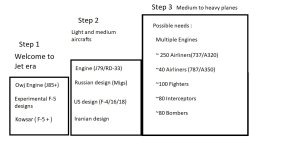
China is a big player now but for the sake of simplicity let's ignore it for now.
Step 1 is done ( let's not forget for a country without production experience it was and is big achievement )
Let's assume needs of step 3 (pocket friendly numbers for future ) then go back to that questions of step 2.(you may ignore airliners for now too )
Based on step 1 and 3, What is the best path at step 2 for future ?Which engine and what design ?
Cancerous Tumor
Full Member
- Dec 22, 2023
- 126
- 67
I have no idea that what year it is.What year is it from?
Wholesome momentF4 vs F18 is a unique fight.
AmirIGM
Senior Member
- Dec 13, 2015
- 4,224
- 8,752
- Country of Origin

- Country of Residence

Yes, I was just adding some context for readers. I also wanted to make sure that people didn't think an X-band AESA could switch to S-band or L-band or anything like that... it stays broadly within X-band just making constant micro-hops along the frequency.I mentioned that when I was describing the benefits of AESA operating in several frequencies. You have to take the entire context of what I wrote, it might be more agreeable since it seems to be the same thing you're saying.
Well, what I'm saying is that it's likely the wing leading edge array is used to emit and receive IFF signals when the Su-35 is interrogating an aircraft. After all the "box" is just a processing unit for those signals. It could do other functions as well but as we've discussed IFF and electronic warfare antennas are often separate from the main fire control radar antennas (bird slicers on F-16/18, "TV antennas" on F-14).I think that's what I was trying to say lol. It's part of the entire system as the arrays but is a separate component. It's quite possible it takes inquiring IFF signals from the arrays and then processes them to the IRBIS-E & pilot. In fact, it's more than likely that is its function.
My initial point was to make the distinction that the arrays main function is radar detection and EW and that component being separate is the main IFF processing unit which only takes signals only from the arrays.
Given the lack of clear details/specs by the manufacturer I'm still not fully sure on the purpose of the AESA arrays but my overall impression would be that they are dedicated to the IFF.
If you look at the context of the quote the article is about Tikhomirov and they are talking about its products. Tikhomirov produces many radars including the AESA radar in the Su-57 and the PESA Irbis radar in the Su-35. So I think it goes like this:with a multifunctional electronic system based on AESA and more than 170 on Su-35S fighters with Irbis radar with phased array.
That could easily be meant that the IRBIS-E is a multifunctional X band multi-role radar with a passive phased antenna array which it is. And besides, the only reason to test them both on the Su-35S and the Su-57 is because they're both the same AESA arrays but applied to two different main radars.
-370 flights conducted to test latest Tikhomirov radars
-100 of them were for the Su-57 and its AESA radar
-170 of them on Su-35 with its Irbis phased array radar
"Last year the institute actively continued its work on aviation topics. According to Yuri Bely, in 2016 an unprecedented amount of test flights were carried out to test the latest Tikhomirov radars - a total of over 370 flights, incl. more than a hundred - on fifth-generation T-50 aircraft with a multifunctional radio-electronic system based on AFAR and more than 170 - on Su-35S fighters with Irbis radar control system with phased array."
Note: AFAR = AESA
-Google translation from http://www.take-off.ru/item/2257-niip-im-v-v-tikhomirova-podvodit-itogi-goda
This video has been circulated many times over the past few years. It does look like an Iranian F-4 tailing an F-18, but no idea on the date of origin or location.View attachment 38855
View attachment 38856View attachment 38857View attachment 38858
few frames from Video of Tabnak.ir
I guess this answers the rumor that the camo has been changed.
So now we have 3 YAK-130’s. Again no proof this isn’t anything more than a test drive for Iran for them to consider if they will place a larger order.
For those misinformed users on here who think Russia has trouble procuring new planes
More SU-35’s delivered to RUAF
More SU-35’s delivered to RUAF
Hack-Hook
INT'L MOD
- Jan 11, 2012
- 21,684
- 18,068
- Country of Origin

- Country of Residence

i'm pretty sure its not an imaging sensorNot an imaging sensor? Are you sure about that? According to the specs, it has TV, IR & TV+IR video and message output to the cockpit's multi-functional display screens and it also has target imaging recognition. So how could it perform all those functions if it doesn't have an imaging sensor?
Click on the pic to enlarge and see the specs.
View attachment 38505
Infrared search and track
The infrared search and track fire control system, OLS-35 IRST, includes an infrared sensor, laser rangefinder, target designator and television camera. The accuracy of the laser rangefinder is 5m CEP (circular error probability), to a maximum range of 20km against airborne targets and 30km against ground targets. The OLS-35 is a high-performance system with ±90° azimuthal and +60°/-15° elevation coverage.
The 20km against airborne targets is different in other sources which goes up to 50km and in some cases listed as 80km for non-afterburning fighters. So there is a distinction to make there if that 20km is for fighters moving in afterburner or not? More likely in afterburner since it doesn't say otherwise. Just wanted to point that possible discrepancy in that pic's information.
I'm pretty sure I know what you're referring to about the Eurofighter, but pls show exactly so we can compare in detail and get down to the nitty gritty, Hacker lol. Bring it, bro!
Users who are viewing this thread
Total: 2 (members: 0, guests: 2)
Pakistan Defence Latest
-
Indian general praises professionalism of Pakistani peacekeepers in South Sudan (12 Viewers)
- Latest: SteppeWolff
-
-
Reports: Bajwa agreed to curtail Pakistan’s ballistic missile program (5 Viewers)
- Latest: Hakikat ve Hikmet
-
-
Country Watch Latest
Latest Posts
-
-
-
-
-
Indian general praises professionalism of Pakistani peacekeepers in South Sudan (12 Viewers)
- Latest: SteppeWolff

